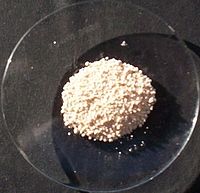Hafnium(IV) oxide
| Hafnium(IV) oxide | |
|---|---|

| |
| General | |
| Other names | hafnium dioxide, hafnia |
| Molecular formula | HfO2 |
| Molar mass | 210.49 g/mol |
| Appearance | white odorless powder |
| CAS number | [12055-23-1] |
| Properties | |
| Density and phase | 9.68 g/cm3, solid |
| Solubility in water | insoluble |
| Melting point | 2758°C |
| Boiling point | 5400°C |
| Vapor density | 9.68 (20°C) |
| Hazards | |
| EU classification | not listed |
| NFPA 704 | |
| Except where noted otherwise, data are given for materials in their standard state (at 25 °C, 100 kPa) Infobox disclaimer and references | |
Hafnium dioxide (HfO2) or hafnia is a hafnium oxide. It is an electrical insulator with a band gap of approximately 6 eV.
Hafnium(IV) oxide reacts with strong acids and strong bases.
Applications
It is used in optical coatings, and as a high-k dielectric in DRAM capacitors. Hafnium based oxides are currently leading candidates to replace silicon oxide as a gate insulator in field effect transistors.
Appears to have planned use by both IBM and Intel to continue scaling down semiconductor features to continue Moore's Law, to continue to increase logic density in computer processors, increase clock speeds, or lower power consumption. See articles:
http://money.cnn.com/2007/01/27/technology/bc.microchips.reut/index.htm
http://www.nytimes.com/2007/01/27/technology/27chip.html
External links
